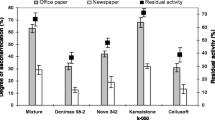Abstract
Enzymatic hydrolysis of waste office paper was evaluated using three commercial cellulases, Acremonium cellulase, Meicelase, and Cellulosin T2. Varying the enzyme loading from 1 to 10% (w/w) conversion of waste office paper to reducing sugar was investigated. The conversion increased with the increase in the enzyme loading: in the case of enzyme loading of 10% (w/w), Acremonium cellulase yielded 79% conversion of waste office paper, which was 17% higher compared to Meicelase, 13% higher than that of Cellulosin T2. Empirical model for the conversion (%) of waste office paper to reducing sugar (x) was derived from experimental results as follow,x=kE m t (aE+b) wherek, m, a, and d denote empirical constants.E indicates initial enzyme concentration.
Similar content being viewed by others
References
Scott, C. D., B. H. Davison, T. C. Scott, J. Woodward, C. Dees, and D. s. Rothrock (1994) An advanced bioprocessing concept for the conversion of waste paper to ethanol.Appl. Biochem. Biotechnol. 45/46: 641–653.
Wayman, M., S. Chen, and K. Doan (1993) Production of fuel ethanol from the waste paper in garbage.Trans IchemE. 71: 141–143.
Wayman, C. E. (1994) Ethanol from lignocelluosic biomass: technology, ecnomics, and opportunities.Bioresour. Technol. 50: 3–16.
Zheng, Y., H.-M. Lin, and G. T. Tsao (1998) Pretreatment for cellulose hydrolysis by carbon dioxide explosion.Biotechnol. Prog. 14: 890–896.
Wood, B. E., H. C. Aldrich, and L. O. Ingram (1997) Ultrasound stimulates ethanol production during the simultaneous saccharification and fermentation of mixed waste office paper.Biotechnol. Prog. 13: 232–237.
Wu, J. and L.-K. Ju (1998) Enhancing enzymatic saccharification of waste newspaper by surfactant addition.Biotechnol. Prog. 14: 649–652.
Park, E. Y., A. Michinaka, and N. Okuda (2001) Enzymatic hydrolysis of waste office paper using viscosity as operation parameter.Biotechnol. Prog. 17: 379–382.
Fan, L. T., M. M. Gharpuray, and Y.-H. Lee (1987)Cellulose Hydrolysis. Springer-Verlag, New York USA.
Howell, J. A. and M. Mangat (1978) Enzyme deactivation during cellulose hydrolysis.Biotechnol. Bioeng. 26: 936–941.
Walseth, C. S. (1952) Occurrence of cellulases in enzyme preparations from microorganisms.Tappi 35: 228–233.
Ghose, T. K. (1987) International union of pure and applied chemistry. Applied chemistry division commission on biotechnology. Measurement of cellulase activities.Pure Appl. Chem. 59: 257–268.
Sosulski, K. and B. Swerhone (1993)Waste Paper and Pulp Sludge as Feedstock for Ethanol Production. US DOE Report NREL-CP-200-5768, 2: 1032–1044.
Author information
Authors and Affiliations
Corresponding author
Rights and permissions
About this article
Cite this article
Park, E.Y., Ikeda, Y. & Okuda, N. Empirical evaluation of cellulase on enzymatic hydrolysis of waste office paper. Biotechnol. Bioprocess Eng. 7, 268–274 (2002). https://doi.org/10.1007/BF02932835
Received:
Accepted:
Issue Date:
DOI: https://doi.org/10.1007/BF02932835




